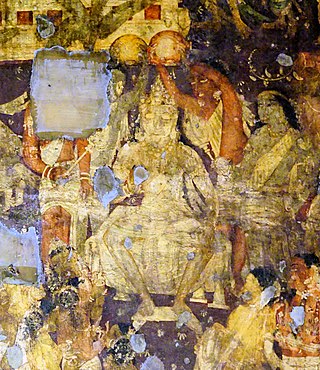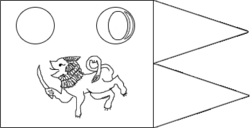
The Sinhalese people, also known as the Sinhalese or Sinhala people are an Indo-Aryan ethno-linguistic group native to the island of Sri Lanka. They are the largest ethnic group in Sri Lanka, constituting about 75% of the Sri Lankan population and number more than 15.2 million.

Dutugamunu the Great, also known as Duṭṭhagāmaṇī Abhaya, was a king of the Anuradhapura Kingdom who reigned from 161 BC to 137 BC. He is renowned for first uniting the whole island of Sri Lanka by defeating and overthrowing Elara, a Tamil trader from the Chola Kingdom, who had invaded the Anuradhapura kingdom in 205 BC. Dutugamunu also expanded and beautified the city of Anuradhapura and projected the power of the Rajarata kingdom across the island of Sri Lanka.

Prince Vijaya was a legendary king of Tambapanni, based in modern day Sri Lanka. His reign was first mentioned in Mahāvaṃsa. He is said to have came to Sri Lanka with a seven hundred followers after being banished from Sinhapura. However, there is no archaeological evidence of this.
Kuveni, (කුවේණි/குவேணி) also known as Sesapathi or Kuvanna or Leelawathi, was a Yakshini queen in Sri Lanka mentioned in the ancient Pali chronicles Mahavansa and Dipavansa of the Sinhalese people. The primary source for her life-story is the Mahavansa. She is venerated as Maha Loku Kiriammaleththo by the Veddas. Other names for her varying with Veddas habitats are Indigolle Kiriamma, Unapane Kiriamma, Kande Kiriamma, Divas Kiriamma, Wellasse Kiriamma, Kukulapola Kiriamma and Bili Kiriamma.

Vaṅga was an ancient kingdom and geopolitical division within the Ganges delta in the Indian subcontinent. The kingdom is one of the namesakes of the Bengal region. It was located in southern Bengal, with the core region including the southern part of present-day West Bengal (India) and southwestern Bangladesh. Vanga features prominently in the epics and tales of ancient India as well as in the history of Sri Lanka.

The Dīpavaṃsa is the oldest historical record of Sri Lanka. The chronicle is believed to be compiled from Atthakatha and other sources around the 3rd to 4th century CE. Together with the Mahāvaṃsa, it is the source of many accounts of the ancient history of Sri Lanka and India. Its importance resides not only as a source of history and legend but also as an important early work in Buddhist and Pali literature.

Sihor is a town, a municipality in Bhavnagar district in the Indian state of Gujarat. Placed along the river Gautami, this erstwhile capital of the Gohil Rajputs, surrounded by hills is situated about 20 km from Bhavnagar. It becomes Sihor by corrupting its name from Saraswatpur, Sinhalpur, Sinhpur, Sinhor, and Shihor.
Queen Anula of Anuradhapura was the first queen regnant in Sri Lankan history, as well as the first documented female head of state in Asia. Anula initially rose to power as a consort of King Chore Naga, son of King Valagambahu of Anuradhapura. However, in her five-year reign, she poisoned her way through at least four other husbands and consorts, causing her to govern Rajarata on her own eventually. Queen Anula of Anuradhapura differs from another famous figure in Sri Lankan history, also named Anula. She is a different figure as she is King Devanampiyatissa's sister-in-law, the first woman in Sri Lanka to be ordained as a bikkhuni. The primary source for Anula's reign is the Mahavamsa, chapters 34 and 35.

The Nayaks of Kandy were the rulers of the Kingdom of Kandy between 1739 and 1815, and the last dynasty to rule on the island. The term Nayak is derived from the Sanskrit word Nāyaka. Their rise to power came about as a result of the death of Vira Narendrasinha, who left no legitimate heir- the throne passed to his brother-in-law, who was crowned as Sri Vijaya Rajasinha in 1739. They were of Telugu Balija origin, spoke Telugu and Tamil, and used Sinhala and Tamil as their court languages. They are also credited for building various Vishnu temples in Sri Lanka dedicated to their clan deity Vishnu, known as Upulvan in Sinhala. A prominent one of them was the Kandy Vishnu Temple established at their capital Kandy. A cadet branch of the Madurai Nayak dynasty, the Kandyan Nayaks were related to the Thanjavur Nayaks as well. Both Madurai and Thanjavur nayaks belonged to Balija caste.
Abhaya was king of Upatissa Nuwara from 474 BC to 454 BC. He succeeded his father Panduvasdeva after being chosen by his siblings as the oldest among them to be the next monarch of Upatissa Nuwara. He was succeeded by his brother, Tissa.
Pandukabhaya was a king of Upatissa Nuwara and the first monarch of the Anuradhapura Kingdom and 6th over all of the island of Sri Lanka since the arrival of the Vijaya; he reigned from 437 BC to 367 BC. According to many historians and philosophers, he is the first truly Sri Lankan king since the Vijayan migration, and also the king who ended the conflict between the Sinha clan and the local clans, reorganising the population.

Nissanka Malla, also known as Keerti Nissanka and Kalinga Lokesvara was a king of Polonnaruwa who ruled the country from 1187 to 1196. He is known for his architectural constructions such as the Nissanka Lata Mandapaya, Hatadage and Rankot Vihara, as well as for the refurbishment of old temples and irrigation tanks.

Sri Veera Parackrama Narendrasinghe was the last Sinhalese King of Sri Lanka of the Kingdom of Kandy. He was also known as the "Prince of Kundasale".

The Kingdom of Tambapaṇṇī was the first Sinhalese kingdom in Sri Lanka. Its administrative centre was based at Tambapaṇṇī. It existed between 543 BC and 437 BC. According to the Mahavamsa, the Kingdom was founded by Prince Vijaya and his followers.
Sinhapura was the capital of the legendary Indian king Sinhabahu. It has been mentioned in the Buddhist legends about Prince Vijaya. The name is also transliterated as Sihapura or Singhapura.
Jettha Tissa I also referred to as Dethutis, Kalakandetu Tissa, and Makalan Detu Tissa, was the eldest son of Gothabhaya and brother of Mahasena. He was a king of Sri Lanka for ten years.
Ilanaga, also known as Elunna, was King of Anuradhapura in the 1st century, whose reign lasted from 38 to 44. He overthrew and succeeded his aunt Sivali as King of Anuradhapura and was succeeded by his son Chandamukha.

The Sinhalese monarchy has its origins in the settlement of North Indian Indo-Aryan immigrants to the island of Sri Lanka. The Landing of Vijay as described in the traditional chronicles of the island, the Dipavamsa, Mahavamsa and Culavamsa, and later chronicles, recount the date of the establishment of the first Sinhala Kingdom in 543 BC when Prince Vijaya, an Indian Prince, and 700 of his followers are claimed to have landed on the island of Sri Lanka and established the Kingdom of Tambapanni. In Sinhalese mythology, Prince Vijaya and followers are told to be the progenitors of the Sinhalese people. However according to the story in the Divyavadana, the immigrants were probably not led by a scion of a royal house in India, as told in the romantic legend, but rather may have been groups of adventurous and pioneering merchants exploring new lands.

The Pre-Anuradhapura period of Sri Lankan history begins with the gradual onset of historical records in the final centuries of the prehistoric period and ending in 437 BC. According to the Mahavamsa, the original inhabitants of Sri Lanka are the Yakshas and northern Naga tribes. Sinhalese history traditionally starts in 543 BC at the arrival of Prince Vijaya, a semi-legendary king who was banished from the Indian subcontinent with his 700 followers, and is recorded in the Mahavamsa chronicle. This period was succeeded by the Anuradhapura period.












